File size: 22,185 Bytes
7b8fdad |
1 2 3 4 5 6 7 8 9 10 11 12 13 14 15 16 17 18 19 20 21 22 23 24 25 26 27 28 29 30 31 32 33 34 35 36 37 38 39 40 41 42 43 44 45 46 47 48 49 50 51 52 53 54 55 56 57 58 59 60 61 62 63 64 65 66 67 68 69 70 71 72 73 74 75 76 77 78 79 80 81 82 83 84 85 86 87 88 89 90 91 92 93 94 95 96 97 98 99 100 101 102 103 104 105 106 107 108 109 110 111 112 113 114 115 116 117 118 119 120 121 122 123 124 125 126 127 128 129 130 131 132 133 134 135 136 137 138 139 140 141 142 143 144 145 146 147 148 149 150 151 152 153 154 155 156 157 158 159 160 161 162 163 164 165 166 167 168 169 170 171 172 173 174 175 176 177 178 179 180 181 182 183 184 185 186 187 188 189 190 191 192 193 194 195 196 197 198 199 200 201 202 203 204 205 206 207 208 209 210 211 212 213 214 215 216 217 218 219 220 221 222 223 224 225 226 227 228 229 230 231 232 233 234 235 236 237 238 239 240 241 242 243 244 245 246 247 248 249 250 251 252 253 254 255 256 257 258 259 260 261 262 263 264 265 266 267 268 269 270 271 272 273 274 275 276 277 278 279 280 281 282 283 284 285 286 287 288 289 290 291 292 293 294 295 296 297 298 299 300 301 302 303 304 305 306 307 308 309 310 311 312 313 314 315 316 317 318 319 320 321 322 323 324 325 326 327 328 329 330 331 332 333 334 335 336 337 338 339 340 341 342 343 344 345 346 347 348 349 350 351 352 353 354 355 356 357 358 359 360 361 362 363 364 365 366 367 368 369 370 371 372 373 374 375 376 377 378 379 380 381 382 383 384 385 386 387 388 389 390 391 392 393 394 395 396 397 398 399 400 401 402 403 404 405 406 407 408 409 410 411 412 413 414 415 416 417 418 419 420 421 422 423 424 425 426 427 428 429 430 431 432 433 434 435 436 437 438 439 440 441 442 443 444 445 446 447 448 449 450 451 452 453 454 455 456 457 458 459 460 461 462 463 464 465 466 467 468 469 470 471 472 473 474 475 476 477 478 479 480 481 482 483 484 485 486 487 488 489 490 491 492 493 494 495 496 497 498 499 500 501 502 503 504 505 506 507 508 509 510 511 512 513 514 515 516 517 518 519 520 521 522 523 524 525 526 527 528 529 530 531 532 533 534 535 536 537 538 539 540 541 542 543 544 545 546 547 548 549 550 551 552 553 554 555 556 557 558 559 560 561 562 563 564 565 566 567 568 569 570 571 572 573 574 575 576 577 578 579 580 581 582 583 584 585 586 587 588 589 590 591 592 593 594 595 596 597 598 599 600 601 602 603 604 605 606 607 608 609 610 611 612 613 614 615 616 617 618 619 620 621 622 623 624 625 626 627 628 629 630 631 632 633 634 635 636 637 638 639 640 641 642 643 644 645 646 647 648 649 650 651 652 653 654 655 656 657 658 659 660 661 662 663 664 665 666 667 668 669 670 671 672 673 674 675 676 677 678 679 680 681 682 683 684 685 686 687 688 |
# Case Study: A Component to Display PDFs
Let's work through an example of building a custom gradio component for displaying PDF files.
This component will come in handy for showcasing [document question answering](https://huggingface.co/models?pipeline_tag=document-question-answering&sort=trending) models, which typically work on PDF input.
This is a sneak preview of what our finished component will look like:
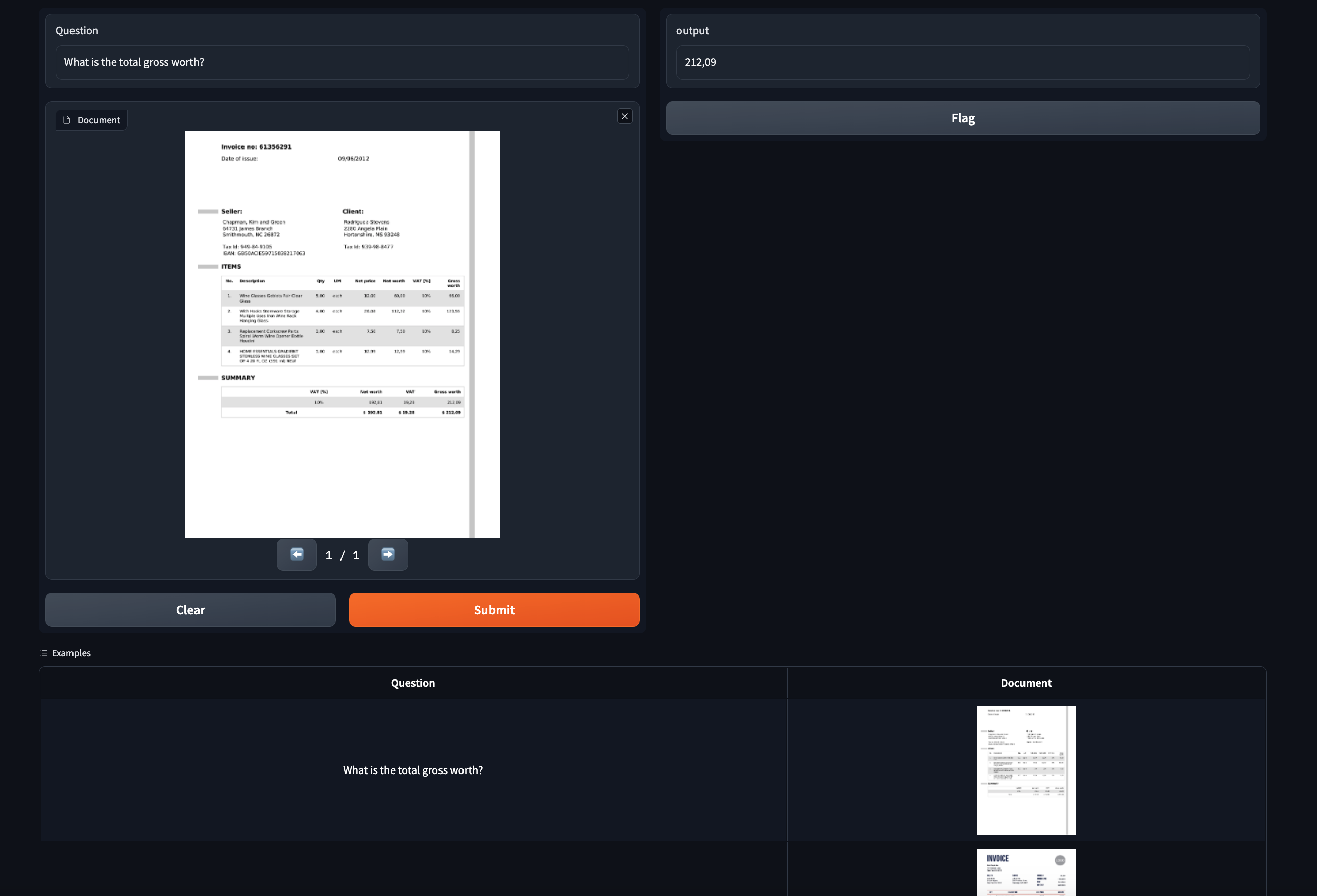
## Step 0: Prerequisites
Make sure you have gradio 4.0 installed as well as node 18+.
As of the time of publication, the latest release is 4.1.1.
Also, please read the [Five Minute Tour](./custom-components-in-five-minutes) of custom components and the [Key Concepts](./key-component-concepts) guide before starting.
## Step 1: Creating the custom component
Navigate to a directory of your choosing and run the following command:
```bash
gradio cc create PDF
```
Tip: You should change the name of the component.
Some of the screenshots assume the component is called `PDF` but the concepts are the same!
This will create a subdirectory called `pdf` in your current working directory.
There are three main subdirectories in `pdf`: `frontend`, `backend`, and `demo`.
If you open `pdf` in your code editor, it will look like this:
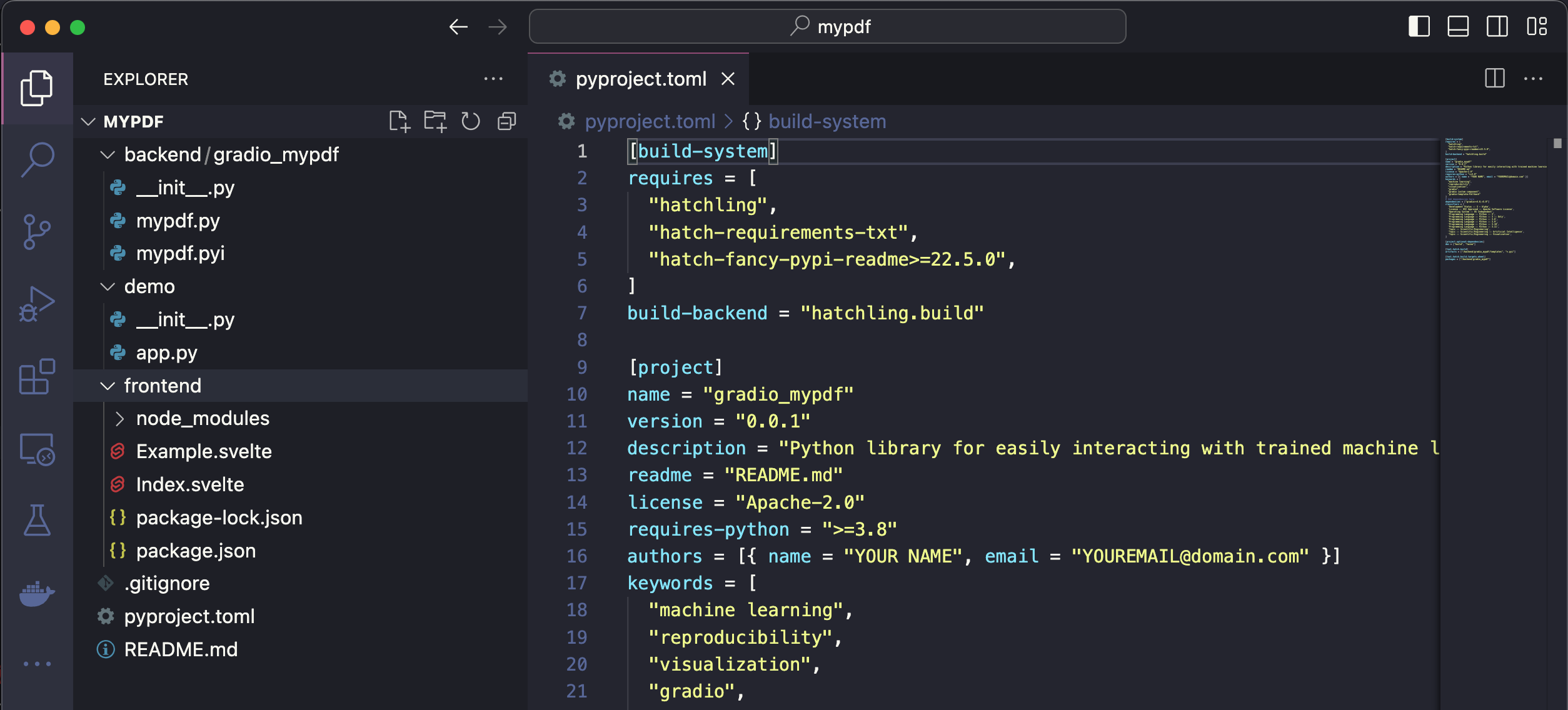
Tip: For this demo we are not templating off a current gradio component. But you can see the list of available templates with `gradio cc show` and then pass the template name to the `--template` option, e.g. `gradio cc create <Name> --template <foo>`
## Step 2: Frontend - modify javascript dependencies
We're going to use the [pdfjs](https://mozilla.github.io/pdf.js/) javascript library to display the pdfs in the frontend.
Let's start off by adding it to our frontend project's dependencies, as well as adding a couple of other projects we'll need.
From within the `frontend` directory, run `npm install @gradio/client @gradio/upload @gradio/icons @gradio/button` and `npm install --save-dev pdfjs-dist@3.11.174`.
Also, let's uninstall the `@zerodevx/svelte-json-view` dependency by running `npm uninstall @zerodevx/svelte-json-view`.
The complete `package.json` should look like this:
```json
{
"name": "gradio_pdf",
"version": "0.2.0",
"description": "Gradio component for displaying PDFs",
"type": "module",
"author": "",
"license": "ISC",
"private": false,
"main_changeset": true,
"exports": {
".": "./Index.svelte",
"./example": "./Example.svelte",
"./package.json": "./package.json"
},
"devDependencies": {
"pdfjs-dist": "3.11.174"
},
"dependencies": {
"@gradio/atoms": "0.2.0",
"@gradio/statustracker": "0.3.0",
"@gradio/utils": "0.2.0",
"@gradio/client": "0.7.1",
"@gradio/upload": "0.3.2",
"@gradio/icons": "0.2.0",
"@gradio/button": "0.2.3",
"pdfjs-dist": "3.11.174"
}
}
```
Tip: Running `npm install` will install the latest version of the package available. You can install a specific version with `npm install package@<version>`. You can find all of the gradio javascript package documentation [here](https://www.gradio.app/main/docs/js). It is recommended you use the same versions as me as the API can change.
Navigate to `Index.svelte` and delete mentions of `JSONView`
```ts
import { JsonView } from "@zerodevx/svelte-json-view";
```
```svelte
<JsonView json={value} />
```
## Step 3: Frontend - Launching the Dev Server
Run the `dev` command to launch the development server.
This will open the demo in `demo/app.py` in an environment where changes to the `frontend` and `backend` directories will reflect instantaneously in the launched app.
After launching the dev server, you should see a link printed to your console that says `Frontend Server (Go here): ... `.
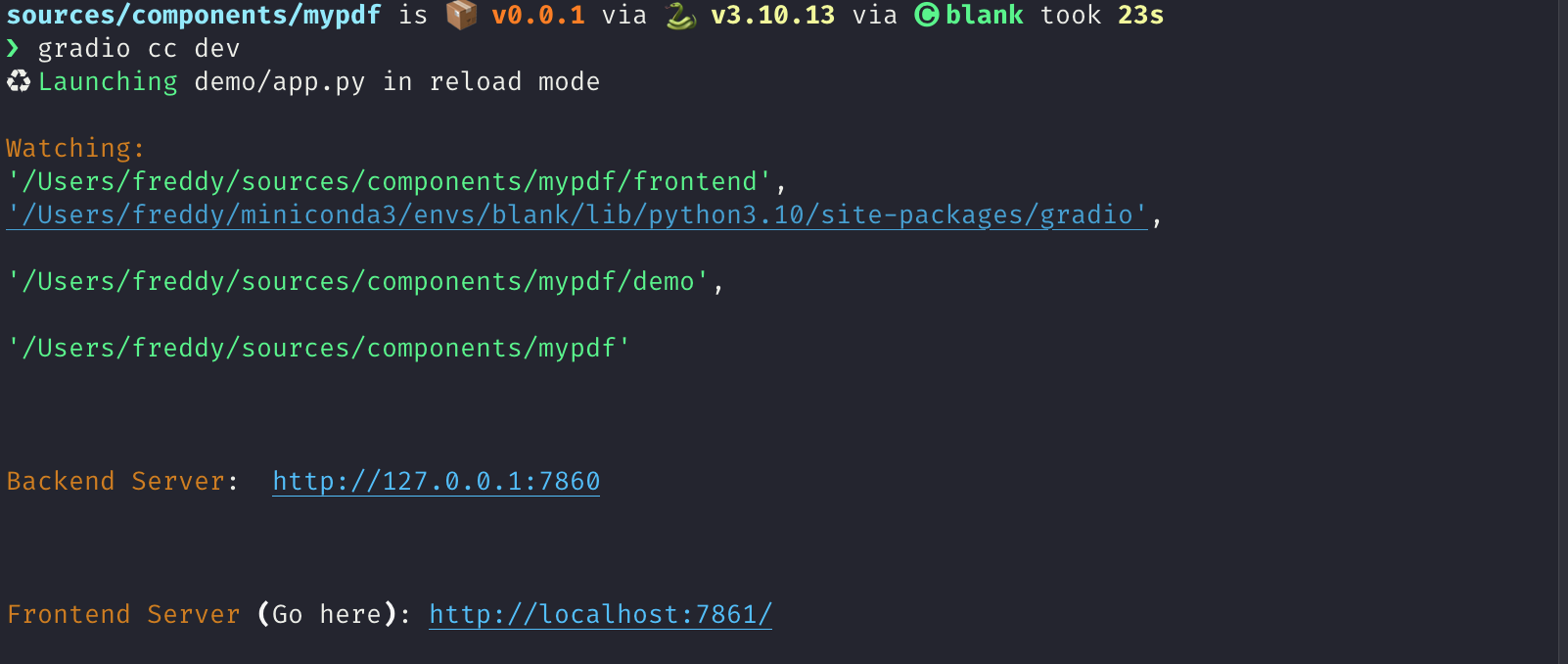
You should see the following:

Its not impressive yet but we're ready to start coding!
## Step 4: Frontend - The basic skeleton
We're going to start off by first writing the skeleton of our frontend and then adding the pdf rendering logic.
Add the following imports and expose the following properties to the top of your file in the `<script>` tag.
You may get some warnings from your code editor that some props are not used.
That's ok.
```ts
import { tick } from "svelte";
import type { Gradio } from "@gradio/utils";
import { Block, BlockLabel } from "@gradio/atoms";
import { File } from "@gradio/icons";
import { StatusTracker } from "@gradio/statustracker";
import type { LoadingStatus } from "@gradio/statustracker";
import type { FileData } from "@gradio/client";
import { Upload, ModifyUpload } from "@gradio/upload";
export let elem_id = "";
export let elem_classes: string[] = [];
export let visible = true;
export let value: FileData | null = null;
export let container = true;
export let scale: number | null = null;
export let root: string;
export let height: number | null = 500;
export let label: string;
export let proxy_url: string;
export let min_width: number | undefined = undefined;
export let loading_status: LoadingStatus;
export let gradio: Gradio<{
change: never;
upload: never;
}>;
let _value = value;
let old_value = _value;
```
Tip: The `gradio`` object passed in here contains some metadata about the application as well as some utility methods. One of these utilities is a dispatch method. We want to dispatch change and upload events whenever our PDF is changed or updated. This line provides type hints that these are the only events we will be dispatching.
We want our frontend component to let users upload a PDF document if there isn't one already loaded.
If it is loaded, we want to display it underneath a "clear" button that lets our users upload a new document.
We're going to use the `Upload` and `ModifyUpload` components that come with the `@gradio/upload` package to do this.
Underneath the `</script>` tag, delete all the current code and add the following:
```svelte
<Block {visible} {elem_id} {elem_classes} {container} {scale} {min_width}>
{#if loading_status}
<StatusTracker
autoscroll={gradio.autoscroll}
i18n={gradio.i18n}
{...loading_status}
/>
{/if}
<BlockLabel
show_label={label !== null}
Icon={File}
float={value === null}
label={label || "File"}
/>
{#if _value}
<ModifyUpload i18n={gradio.i18n} absolute />
{:else}
<Upload
filetype={"application/pdf"}
file_count="single"
{root}
>
Upload your PDF
</Upload>
{/if}
</Block>
```
You should see the following when you navigate to your app after saving your current changes:

## Step 5: Frontend - Nicer Upload Text
The `Upload your PDF` text looks a bit small and barebones.
Lets customize it!
Create a new file called `PdfUploadText.svelte` and copy the following code.
Its creating a new div to display our "upload text" with some custom styling.
Tip: Notice that we're leveraging Gradio core's existing css variables here: `var(--size-60)` and `var(--body-text-color-subdued)`. This allows our component to work nicely in light mode and dark mode, as well as with Gradio's built-in themes.
```svelte
<script lang="ts">
import { Upload as UploadIcon } from "@gradio/icons";
export let hovered = false;
</script>
<div class="wrap">
<span class="icon-wrap" class:hovered><UploadIcon /> </span>
Drop PDF
<span class="or">- or -</span>
Click to Upload
</div>
<style>
.wrap {
display: flex;
flex-direction: column;
justify-content: center;
align-items: center;
min-height: var(--size-60);
color: var(--block-label-text-color);
line-height: var(--line-md);
height: 100%;
padding-top: var(--size-3);
}
.or {
color: var(--body-text-color-subdued);
display: flex;
}
.icon-wrap {
width: 30px;
margin-bottom: var(--spacing-lg);
}
@media (--screen-md) {
.wrap {
font-size: var(--text-lg);
}
}
.hovered {
color: var(--color-accent);
}
</style>
```
Now import `PdfUploadText.svelte` in your `<script>` and pass it to the `Upload` component!
```svelte
import PdfUploadText from "./PdfUploadText.svelte";
...
<Upload
filetype={"application/pdf"}
file_count="single"
{root}
>
<PdfUploadText />
</Upload>
```
After saving your code, the frontend should now look like this:

## Step 6: PDF Rendering logic
This is the most advanced javascript part.
It took me a while to figure it out!
Do not worry if you have trouble, the important thing is to not be discouraged 💪
Ask for help in the gradio [discord](https://discord.gg/hugging-face-879548962464493619) if you need and ask for help.
With that out of the way, let's start off by importing `pdfjs` and loading the code of the pdf worker from the mozilla cdn.
```ts
import pdfjsLib from "pdfjs-dist";
...
pdfjsLib.GlobalWorkerOptions.workerSrc = "https://cdn.bootcss.com/pdf.js/3.11.174/pdf.worker.js";
```
Also create the following variables:
```ts
let pdfDoc;
let numPages = 1;
let currentPage = 1;
let canvasRef;
```
Now, we will use `pdfjs` to render a given page of the PDF onto an `html` document.
Add the following code to `Index.svelte`:
```ts
async function get_doc(value: FileData) {
const loadingTask = pdfjsLib.getDocument(value.url);
pdfDoc = await loadingTask.promise;
numPages = pdfDoc.numPages;
render_page();
}
function render_page() {
// Render a specific page of the PDF onto the canvas
pdfDoc.getPage(currentPage).then(page => {
const ctx = canvasRef.getContext('2d')
ctx.clearRect(0, 0, canvasRef.width, canvasRef.height);
let viewport = page.getViewport({ scale: 1 });
let scale = height / viewport.height;
viewport = page.getViewport({ scale: scale });
const renderContext = {
canvasContext: ctx,
viewport,
};
canvasRef.width = viewport.width;
canvasRef.height = viewport.height;
page.render(renderContext);
});
}
// If the value changes, render the PDF of the currentPage
$: if(JSON.stringify(old_value) != JSON.stringify(_value)) {
if (_value){
get_doc(_value);
}
old_value = _value;
gradio.dispatch("change");
}
```
Tip: The `$:` syntax in svelte is how you declare statements to be reactive. Whenever any of the inputs of the statement change, svelte will automatically re-run that statement.
Now place the `canvas` underneath the `ModifyUpload` component:
```svelte
<div class="pdf-canvas" style="height: {height}px">
<canvas bind:this={canvasRef}></canvas>
</div>
```
And add the following styles to the `<style>` tag:
```svelte
<style>
.pdf-canvas {
display: flex;
justify-content: center;
align-items: center;
}
</style>
```
## Step 7: Handling The File Upload And Clear
Now for the fun part - actually rendering the PDF when the file is uploaded!
Add the following functions to the `<script>` tag:
```ts
async function handle_clear() {
_value = null;
await tick();
gradio.dispatch("change");
}
async function handle_upload({detail}: CustomEvent<FileData>): Promise<void> {
value = detail;
await tick();
gradio.dispatch("change");
gradio.dispatch("upload");
}
```
Tip: The `gradio.dispatch` method is actually what is triggering the `change` or `upload` events in the backend. For every event defined in the component's backend, we will explain how to do this in Step 9, there must be at least one `gradio.dispatch("<event-name>")` call. These are called `gradio` events and they can be listended from the entire Gradio application. You can dispatch a built-in `svelte` event with the `dispatch` function. These events can only be listened to from the component's direct parent. Learn about svelte events from the [official documentation](https://learn.svelte.dev/tutorial/component-events).
Now we will run these functions whenever the `Upload` component uploads a file and whenever the `ModifyUpload` component clears the current file. The `<Upload>` component dispatches a `load` event with a payload of type `FileData` corresponding to the uploaded file. The `on:load` syntax tells `Svelte` to automatically run this function in response to the event.
```svelte
<ModifyUpload i18n={gradio.i18n} on:clear={handle_clear} absolute />
...
<Upload
on:load={handle_upload}
filetype={"application/pdf"}
file_count="single"
{root}
>
<PdfUploadText/>
</Upload>
```
Congratulations! You have a working pdf uploader!
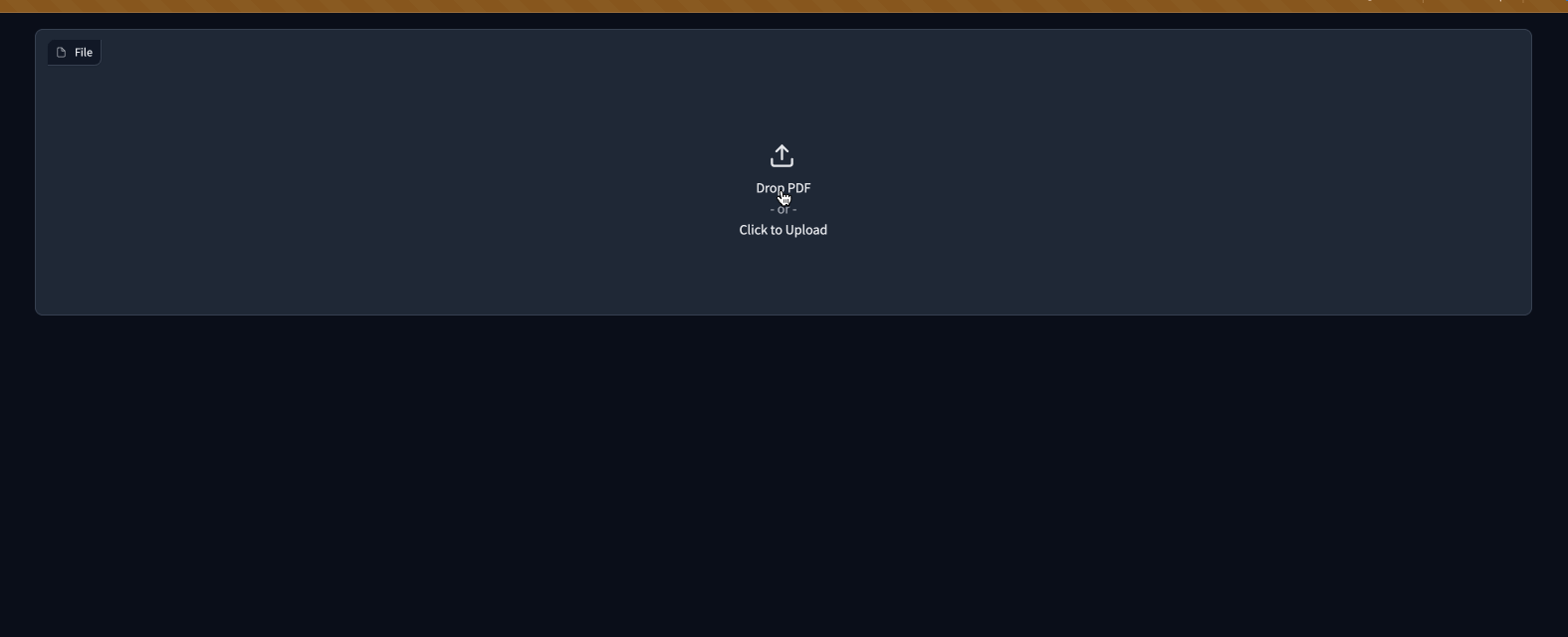
## Step 8: Adding buttons to navigate pages
If a user uploads a PDF document with multiple pages, they will only be able to see the first one.
Let's add some buttons to help them navigate the page.
We will use the `BaseButton` from `@gradio/button` so that they look like regular Gradio buttons.
Import the `BaseButton` and add the following functions that will render the next and previous page of the PDF.
```ts
import { BaseButton } from "@gradio/button";
...
function next_page() {
if (currentPage >= numPages) {
return;
}
currentPage++;
render_page();
}
function prev_page() {
if (currentPage == 1) {
return;
}
currentPage--;
render_page();
}
```
Now we will add them underneath the canvas in a separate `<div>`
```svelte
...
<ModifyUpload i18n={gradio.i18n} on:clear={handle_clear} absolute />
<div class="pdf-canvas" style="height: {height}px">
<canvas bind:this={canvasRef}></canvas>
</div>
<div class="button-row">
<BaseButton on:click={prev_page}>
⬅️
</BaseButton>
<span class="page-count"> {currentPage} / {numPages} </span>
<BaseButton on:click={next_page}>
➡️
</BaseButton>
</div>
...
<style>
.button-row {
display: flex;
flex-direction: row;
width: 100%;
justify-content: center;
align-items: center;
}
.page-count {
margin: 0 10px;
font-family: var(--font-mono);
}
```
Congratulations! The frontend is almost complete 🎉
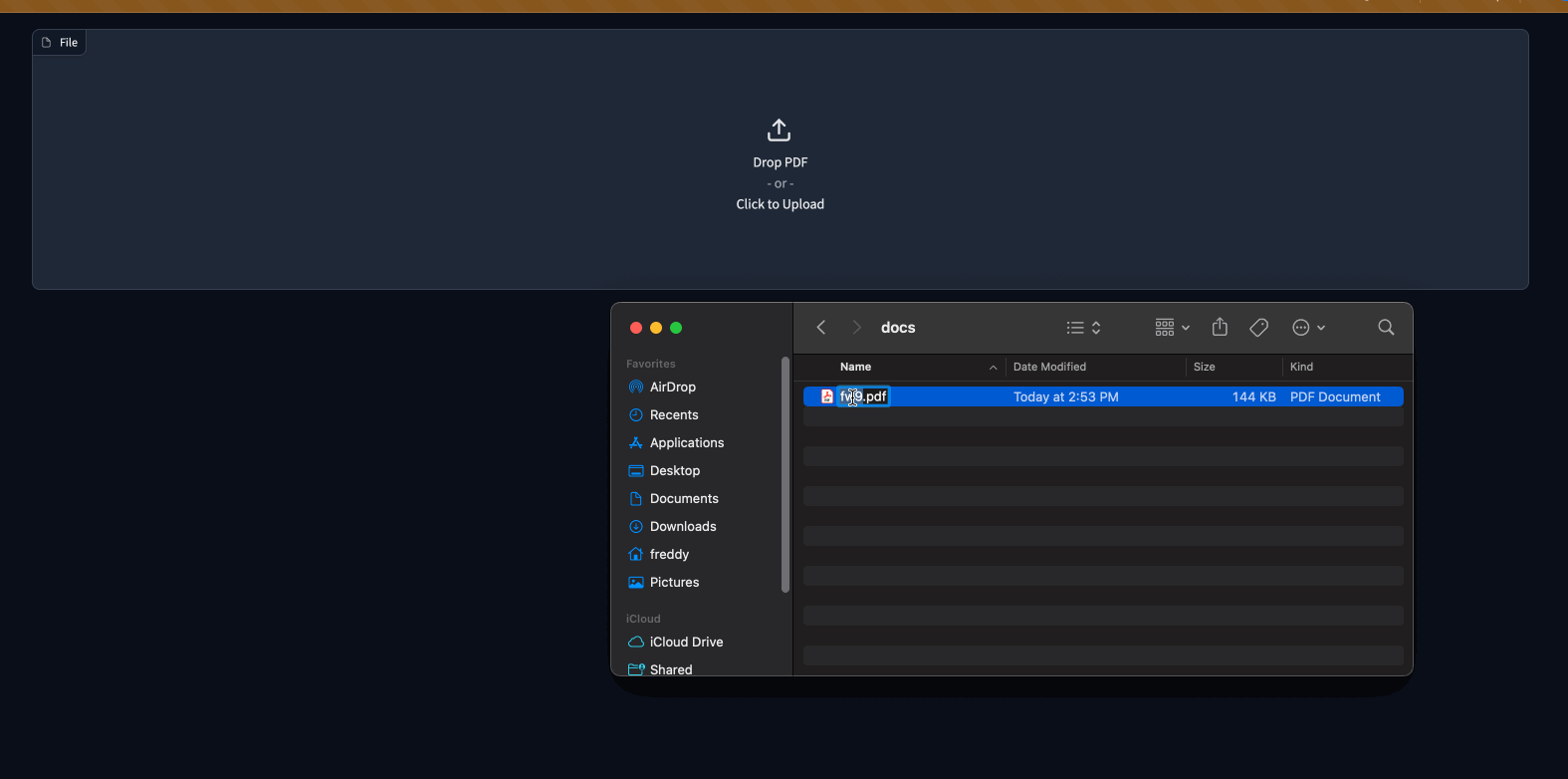
## Step 8.5: The Example view
We're going to want users of our component to get a preview of the PDF if its used as an `example` in a `gr.Interface` or `gr.Examples`.
To do so, we're going to add some of the pdf rendering logic in `Index.svelte` to `Example.svelte`.
```svelte
<script lang="ts">
export let value: string;
export let type: "gallery" | "table";
export let selected = false;
import pdfjsLib from "pdfjs-dist";
pdfjsLib.GlobalWorkerOptions.workerSrc = "https://cdn.bootcss.com/pdf.js/3.11.174/pdf.worker.js";
let pdfDoc;
let canvasRef;
async function get_doc(url: string) {
const loadingTask = pdfjsLib.getDocument(url);
pdfDoc = await loadingTask.promise;
renderPage();
}
function renderPage() {
// Render a specific page of the PDF onto the canvas
pdfDoc.getPage(1).then(page => {
const ctx = canvasRef.getContext('2d')
ctx.clearRect(0, 0, canvasRef.width, canvasRef.height);
const viewport = page.getViewport({ scale: 0.2 });
const renderContext = {
canvasContext: ctx,
viewport
};
canvasRef.width = viewport.width;
canvasRef.height = viewport.height;
page.render(renderContext);
});
}
$: get_doc(value);
</script>
<div
class:table={type === "table"}
class:gallery={type === "gallery"}
class:selected
style="justify-content: center; align-items: center; display: flex; flex-direction: column;"
>
<canvas bind:this={canvasRef}></canvas>
</div>
<style>
.gallery {
padding: var(--size-1) var(--size-2);
}
</style>
```
Tip: Exercise for the reader - reduce the code duplication between `Index.svelte` and `Example.svelte` 😊
You will not be able to render examples until we make some changes to the backend code in the next step!
## Step 9: The backend
The backend changes needed are smaller.
We're almost done!
What we're going to do is:
* Add `change` and `upload` events to our component.
* Add a `height` property to let users control the height of the PDF.
* Set the `data_model` of our component to be `FileData`. This is so that Gradio can automatically cache and safely serve any files that are processed by our component.
* Modify the `preprocess` method to return a string corresponding to the path of our uploaded PDF.
* Modify the `postprocess` to turn a path to a PDF created in an event handler to a `FileData`.
When all is said an done, your component's backend code should look like this:
```python
from __future__ import annotations
from typing import Any, Callable, TYPE_CHECKING
from gradio.components.base import Component
from gradio.data_classes import FileData
from gradio import processing_utils
if TYPE_CHECKING:
from gradio.components import Timer
class PDF(Component):
EVENTS = ["change", "upload"]
data_model = FileData
def __init__(self, value: Any = None, *,
height: int | None = None,
label: str | None = None, info: str | None = None,
show_label: bool | None = None,
container: bool = True,
scale: int | None = None,
min_width: int | None = None,
interactive: bool | None = None,
visible: bool = True,
elem_id: str | None = None,
elem_classes: list[str] | str | None = None,
render: bool = True,
load_fn: Callable[..., Any] | None = None,
every: Timer | float | None = None):
super().__init__(value, label=label, info=info,
show_label=show_label, container=container,
scale=scale, min_width=min_width,
interactive=interactive, visible=visible,
elem_id=elem_id, elem_classes=elem_classes,
render=render, load_fn=load_fn, every=every)
self.height = height
def preprocess(self, payload: FileData) -> str:
return payload.path
def postprocess(self, value: str | None) -> FileData:
if not value:
return None
return FileData(path=value)
def example_payload(self):
return "https://gradio-builds.s3.amazonaws.com/assets/pdf-guide/fw9.pdf"
def example_value(self):
return "https://gradio-builds.s3.amazonaws.com/assets/pdf-guide/fw9.pdf"
```
## Step 10: Add a demo and publish!
To test our backend code, let's add a more complex demo that performs Document Question and Answering with huggingface transformers.
In our `demo` directory, create a `requirements.txt` file with the following packages
```
torch
transformers
pdf2image
pytesseract
```
Tip: Remember to install these yourself and restart the dev server! You may need to install extra non-python dependencies for `pdf2image`. See [here](https://pypi.org/project/pdf2image/). Feel free to write your own demo if you have trouble.
```python
import gradio as gr
from gradio_pdf import PDF
from pdf2image import convert_from_path
from transformers import pipeline
from pathlib import Path
dir_ = Path(__file__).parent
p = pipeline(
"document-question-answering",
model="impira/layoutlm-document-qa",
)
def qa(question: str, doc: str) -> str:
img = convert_from_path(doc)[0]
output = p(img, question)
return sorted(output, key=lambda x: x["score"], reverse=True)[0]['answer']
demo = gr.Interface(
qa,
[gr.Textbox(label="Question"), PDF(label="Document")],
gr.Textbox(),
)
demo.launch()
```
See our demo in action below!
<video autoplay muted loop>
<source src="https://gradio-builds.s3.amazonaws.com/assets/pdf-guide/PDFDemo.mov" type="video/mp4" />
</video>
Finally lets build our component with `gradio cc build` and publish it with the `gradio cc publish` command!
This will guide you through the process of uploading your component to [PyPi](https://pypi.org/) and [HuggingFace Spaces](https://huggingface.co/spaces).
Tip: You may need to add the following lines to the `Dockerfile` of your HuggingFace Space.
```Dockerfile
RUN mkdir -p /tmp/cache/
RUN chmod a+rwx -R /tmp/cache/
RUN apt-get update && apt-get install -y poppler-utils tesseract-ocr
ENV TRANSFORMERS_CACHE=/tmp/cache/
```
## Conclusion
In order to use our new component in **any** gradio 4.0 app, simply install it with pip, e.g. `pip install gradio-pdf`. Then you can use it like the built-in `gr.File()` component (except that it will only accept and display PDF files).
Here is a simple demo with the Blocks api:
```python
import gradio as gr
from gradio_pdf import PDF
with gr.Blocks() as demo:
pdf = PDF(label="Upload a PDF", interactive=True)
name = gr.Textbox()
pdf.upload(lambda f: f, pdf, name)
demo.launch()
```
I hope you enjoyed this tutorial!
The complete source code for our component is [here](https://huggingface.co/spaces/freddyaboulton/gradio_pdf/tree/main/src).
Please don't hesitate to reach out to the gradio community on the [HuggingFace Discord](https://discord.gg/hugging-face-879548962464493619) if you get stuck.
|